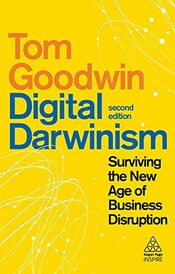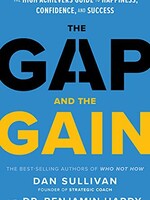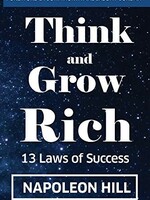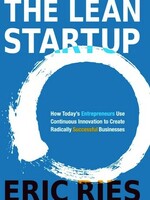
Digital Darwinism - Book Summary
Survival of the Fittest in the Age of Digital Disruption
Release Date: November 16, 2023
Book Author: Tom Goodwin
Categories: Technology & the Future, Management & Leadership, Entrepreneurship
Release Date: November 16, 2023
Book Author: Tom Goodwin
Categories: Technology & the Future, Management & Leadership, Entrepreneurship
In this episode of "20 Minute Books", we will delve into the invigorating world of "Digital Darwinism", authored by the savvy tech intellect, Tom Goodwin. This enlightening book was released in 2018 and has been creating ripples in the industry for its captivating insights on disruptive business models and strategies to stay afloat in the ever-changing global marketplace.
Our author, Tom Goodwin, is not just an accomplished writer, but also the head of innovation at Zenith Media. His contributions to the industry can be traced back to his insightful writings for TechCrunch, the Guardian, Inc., GQ, and Forbes. Renowned for his compelling narratives on technology, advertising, and marketing solutions, Goodwin's writing prowess has graced the pages of prestigious media outlets like the New York Times and the Economist.
"Digital Darwinism" is an exploration into the core of today's business landscapes. The book is tailor-made for voracious learners who find themselves in the diverse realms of entrepreneurship, startups, and established businesses. It equally caters to marketing and sales gurus, searching for the key to thrive amidst the waves of digital transformation. So tune in as we unravel the secrets to survival in the evolving digital economy.
So what's your takeaway? Discover the tactics every business needs to adopt to stay afloat in the future.
Let's take a stroll down memory lane. Think back to the time when Blockbuster was the go-to place for DVD rentals. Remember those blue and yellow signs beckoning movie lovers to come and browse through rows of DVDs? But times changed, and Blockbuster didn't. They stuck to the traditional DVD rental model and as a result, found themselves in the corporate graveyard.
This tragic tale of Blockbuster is one amongst many cautionary narratives of businesses that failed to keep up with the times. The core lessons and advice derived from these stories serve as a roadmap for contemporary businesses aiming to evade a similar downfall. The message is simple yet profound — if a business can't adapt to the digital age, it will simply be left in the dust. This adaption doesn't merely mean nodding in agreement to the trends of the digital world, but to assimilate and incorporate the digital age into the very framework of your business.
The concept of Digital Darwinism stresses the importance of infusing your business DNA with digital elements, going beyond just a snazzy website or virtual tour. As we navigate through the digital era, technology will continue to intertwine seamlessly with our daily lives, much like electricity. This reality isn't far in the future, it's arriving right now — and it's what future-leading businesses need to prepare for.
In the coming moments, we'll dive into why you wouldn't want to follow in the footsteps of Heathrow Airport, explore the misconceptions surrounding the idea of disruption, and examine why just incorporating a chatbot into your business operations barely scratches the surface.
Surviving the digital age means embracing fundamental changes and evolving with the times
You might often hear the phrase "survival of the fittest", but what does it really mean for businesses navigating today's dynamic landscape? Do the big players with their legion of experts and billion-dollar budgets always secure a safe spot at the top? Not necessarily.
Darwinism in the digital era is more about thriving amidst continuous global changes. It's about the ability to stay nimble and adapt swiftly to the unpredictable roller coaster ride of the future.
Mammoth businesses that have been operational for three to five decades aren't necessarily the champions of success. Sometimes, they might find themselves at a disadvantage, boxed in by their traditional ways and finding it challenging to evolve.
Take Sony as an example. Once the market leader in portable music devices like Walkman and Discman, Sony found itself cornered when MP3 and digital music burst onto the scene. The new wave of music presented a lucrative opportunity but also a threat to Sony's existing products. If digital music were to take off, their Walkman and Discman would quickly become obsolete. So, Sony perceived the digital transition as a risky venture into self-disruption. This hesitation cost them their leading position, which was seized by more disruptive contenders.
Far too many businesses mirror this mindset. They dip their toes into the waters of technological innovations, settling for a "bolted-on" approach rather than taking a deep dive. Take banks for instance. Many develop an app that allows checks to be deposited through a photo, instead of reimagining the need for paper checks in a digital world. This is akin to forcing a square peg into a round hole, trying to fit new technology into an antiquated system.
Think of it like London's Heathrow Airport. Despite pumping in substantial funds to modernize it, its geographical limitations make it hard for planes to move around, causing it to remain unwieldy regardless of alterations. Eventually, a new airport will likely emerge that harnesses modern technology from the ground up and offers room for future expansion in a practical location. Trying to revamp an outdated, problematic system is nothing short of a futile exercise.
This is an invaluable lesson for traditional businesses. The key isn't in making minor adjustments to an inefficient system. Rather, true adaption comes from embracing fundamental changes and evolving with the times.
Insights from the eras of electricity, computers, and digitization, hint at what the internet era might look like
The only constant when it comes to the future is its inherent unpredictability. While many might claim to forecast the future, the truth is, it remains shrouded in mystery. However, we can often find clues about what lies ahead in the chronicles of the past.
If we rewind history, we uncover three pivotal eras that showcase a common pattern in business responses to burgeoning technologies. The dawn of electricity and computers, and the subsequent digitization phase, illustrate our current situation with the internet.
During each of these epochs, society displayed a marked resistance towards new technology and was slow to fully incorporate it. Initially, there would be a tumultuous phase where traditional practices clashed with the new technology. Over time, the new technology would permeate society until it became so integral and ubiquitous, it felt as natural as breathing.
Electricity is a prime example of this. While its commercial potential was first realized in the 1830s, it took nearly a century for electricity to become a staple of modern life. The journey towards standardization was slow and factories accustomed to steam power were apprehensive about making the switch.
Furthermore, it was a lengthy process before electricity was leveraged for groundbreaking purposes. For the longest time, companies merely electrified existing machines and appliances. It took considerable time to realize that the need of the hour was not electrified factories, but new factories built with electricity at their core.
We witnessed a similar evolution with computers and digital technology. However, the transition from introduction to widespread acceptance was twice as quick as before. During the 50-year interim period, cautious businesses attempted to digitize a few processes while clinging onto traditional ones.
The digital era, encapsulating the internet, resolved some of the discord from the computer era. The incompatibility between PCs and Macs was bridged by the internet. But here we are once again, observing businesses that merely apply modern technology to the peripheries of their operation.
Deep-seated innovation, not superficial changes, holds the key to true disruption
When we talk about disruption in business, many quote the Harvard scholar Clayton Christensen. He defined disruption as the advent of a new company equipped with innovative technology and lower costs that subverts established corporations. However, this definition doesn't entirely hit the mark.
Consider the major disruptors of recent times, like Uber or Airbnb. Neither did they undercut traditional service providers in terms of price, nor did they merely introduce some shiny new tech. More often than not, an Airbnb stay might even cost more than a conventional hotel room. The real power of disruptors lies in their ability to overhaul existing business paradigms and revolutionize how things are done.
If your aim is to create a genuine disruption in your industry, superficial technological modifications or cheaper prices won't cut it. You need to delve beyond the superficial layers of your business and foster audacious innovation at its heart.
These superficial layers encompass your customer communication strategies, marketing campaigns, product or service offerings, and business functionalities. Most businesses have incorporated tech into these layers, like leveraging email newsletters and social media for marketing. However, only a handful have made a sincere effort to place technology and innovative methods at the crux of their business models.
Hertz, a car rental company, serves as an apt example. They have introduced a system that allows customers to submit recorded videos of their complaints instead of filling out online forms. Although this employs technology, it remains a tool tethered to Hertz's conventional business model. If Hertz was to genuinely embrace the digital revolution, it would overhaul its core business plan to mirror the likes of Zipcar, where the entire rental process is app-driven.
The secret to concocting a truly innovative strategy is to break free from the confines of your industry's traditional boundaries. Businesses like Uber and Airbnb discarded the notion that a company had to own physical assets, like cars or rooms, to offer services. Instead, they made the leap to a model that connects customers to services without needing to own any assets.
When you craft a solution that transcends these boundaries, you're possibly on the cusp of a paradigm shift that can trigger genuine disruption.
Existing businesses can disrupt their own industries through four transformation methods, many of which lack true innovation
Being a new kid on the block is not a prerequisite for disrupting your own industry. Established businesses have four primary routes to invoke meaningful change and cultivate innovation.
First up, self-disruption. This involves betting on a technology or method that could render your current operations obsolete. It's a risky gamble, often referred to as "cannibalism" in business lingo. But if it works, it can be a game-changer.
Netflix serves as a shining example of successful self-disruption. The video rental giant strategically shifted focus from DVD rentals to streaming. In 2007, after sinking 40 million dollars into data storage, Netflix began offering existing members limited streaming hours at no extra charge, all the while steadily growing their streamable content library.
Fast-forward to 2011, Netflix decided to separate DVD rental and streaming subscriptions. They made streaming more affordable and relocated DVD rentals to a new service, Qwikster. This move saw their stock prices plunge from 42 dollars a share to less than 10, with many demanding CEO Reed Hastings' resignation.
But Netflix stuck to its guns, firmly believing in the future of streaming. Their lower subscription fee soon attracted a slew of new subscribers and their content library kept expanding. The result? Their share prices now hover above 100 dollars.
The second strategy is continuous reinvention. Rather than adhering to a rigid, unyielding operational plan, make adaptability the crux of your business. Case in point — Facebook. From a platform for reconnecting with old friends, Facebook has evolved into the world's most powerful media company. It's hardly surprising that Facebook spends millions annually on research and development.
Lastly, businesses can also opt for measured and hedged bets. Measured bets are like BMW's foray into electric vehicles with their BMWi series. While these vehicles don't form the bulk of BMW's profit, they provide a platform for developing new technologies. Who knows? Someday, BMWi technology could revolutionize their other models.
Hedging involves investing in other businesses that might nurture innovative ideas beneficial to the parent company. This strategy is employed by giants like Google, Dell, Cisco, and Intel. It's the driving force behind Google Ventures and explains why DuPont, a chemical and plastics manufacturer, invested in General Motors when it was just a fledgling car company in 1914.
Future projections suggest more fluid online transactions, raising the privacy debate
A decade ago, it was apparent that streaming video was the path to the future. Today, we can make similar predictions about emerging digital technologies.
When uncovering the next big technological advancement, it's beneficial to forecast the potential implications of the current trends. For instance, with the advent of smartphones, innovative thinkers considered the ramifications of this technology, like the explosion of apps, emojis, and various secondary business opportunities unleashed by smartphones.
Currently, there's considerable focus on the "Internet of Things" (IoT) concept, a testament to the upcoming 5G internet service. 5G would allow a greater number of devices to connect with each other in real-time, setting the stage for seamless transactions and unprecedented data processing capabilities.
Nest's digital thermostats serve as a precursor to the IoT landscape. They facilitate easy programming of your home's heating and air-conditioning systems. It's a glimpse into a future where your home's temperature, lighting, and background music can be personalized to greet you as you walk through the door.
Nest's digital thermostat embodies the forward-thinking approach businesses need to adopt, seamlessly integrating digital technology into everyday life. Just as it happened with electricity and computers, tomorrow's leading businesses will spearhead this seamless interaction in digitally connected homes.
Facial recognition technology also provides a taste of what lies ahead. Soon, your face could replace your passport as your primary form of identification. Imagine a future where traveling without a paper passport is possible, where a mere glimpse of your face could authorize payments. Isn't it plausible to consider your bank account and travel permissions being linked to a paperless ID source?
Granted, facial recognition technology and other IoT components do provoke questions about privacy and data security. This necessitates businesses to prioritize transparency and security in handling user data. However, the convenience and value offered by a seamlessly digital life are likely to overshadow these concerns for most people. Hence, the onus falls on future companies to balance data security with providing value, ensuring an equitable exchange for user data.
Differentiate between shopping and buying to overcome digital mishaps and put people over technology
Amazon's one-click-buy feature has garnered acclaim because it recognizes the distinction between shopping and buying. While many businesses focus on making shopping an enjoyable experience, future-looking businesses might want to take a leaf out of Amazon's book and aim for a quick, effortless, and largely forgettable buying process.
If a buying experience is etched in memory, it's typically because it was far from smooth. An optimal buying experience should be as easy as a single button press.
We still encounter numerous digital disappointments, like businesses not supporting your chosen online payment method or geo-restricted streaming of your beloved BBC shows. Technology catches our attention mostly when it fails to deliver. Future industry leaders will be the companies that simplify buying products and streaming content, regardless of the user's geographical location.
Making things seamless and user-friendly isn't about chasing the latest technology. It's about understanding what people desire and simplifying the route to their goal. So, rather than focusing on buzzwords like "interactive" and "digital," consider the tools already in use and think of ways to interconnect them for enhanced user experience.
The digital era is steering us towards a hybrid world, where Bluetooth speakers could become portals to shop and gather information. Soon, geographical boundaries to content may dissolve, and national currencies might lose their importance. It's high time we thought about transcending all barriers to create frictionless experiences for people worldwide with technology that is gradually becoming a constant in our lives.
Consider the buzz around artificial intelligence (AI). While it does promise a revolutionary future, are businesses merely integrating chatbots into their websites as a gesture of utilizing AI?
Truly innovative and disruptive companies will use transformative technologies like AI to accomplish new, groundbreaking tasks. Such organizations will always consider the latest tech as a means to help people in creative ways, making it the core of their business strategy.
Summing it all up
The underlying message is:
Digital darwinism doesn't prioritize the most potent or affluent companies. Instead, it values agility and swift adaptability to an ever-evolving global business landscape. Businesses can carve out a competitive edge by fostering innovation and embracing change as central tenets of their strategy. Moreover, they can focus on going beyond conventional norms, exploring fresh approaches, and making digital era living more seamless for people.





